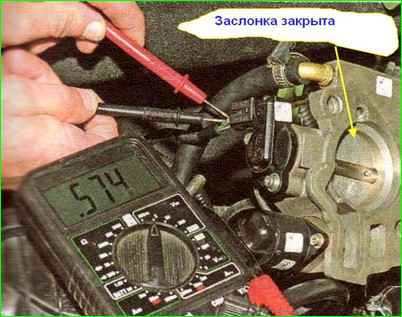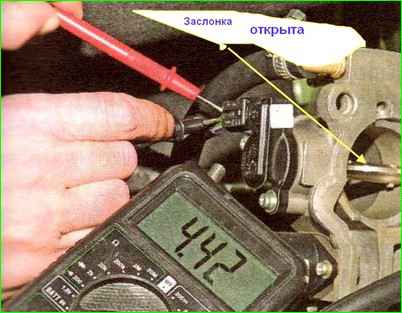The throttle position sensor is mounted on the side of the throttle assembly and is connected to the throttle shaft
The sensor is a potentiometer, one end of which is supplied with a positive supply voltage (5 V), and the other end is connected to ground
From the third terminal of the potentiometer (from the slider) the output signal goes to the controller.
When the throttle valve is turned (by operating the control pedal), the voltage at the sensor output changes.

With the throttle valve closed it is below 0.7 V.
When the damper opens, the voltage at the sensor output increases and should be more than 4 V when the damper is fully open.
By monitoring the sensor output voltage, the controller adjusts the fuel supply depending on the throttle valve opening angle (i.e., at the driver’s request).
The throttle position sensor does not require any adjustment, since the controller perceives idle speed (i.e. completely closing the throttle) as the zero mark.
A specific cause of jerking during steady vehicle movement may be damage to the throttle position sensor.
Additional symptoms confirming the malfunction of this sensor are:
- – uneven operation of the engine at idle;
- – reduction in maximum engine power. The sensor is not dismountable and therefore cannot be repaired. If a sensor malfunction is detected, it is replaced as an assembly.
Checking the throttle sensor response
With the ignition off, disconnect the engine management system wiring harness block from the throttle position sensor.

Terminals “A” and “B” are indicated on the plug retainer, and terminal “C” is marked on the opposite side of the plug body.

To check the power circuit of the sensor itself, connect the tester to terminals “A” and “B” of the plug.
The voltage should be 4.8 - 5.2 volts.
If there is no voltage at these terminals, then you need to check the serviceability of the circuit itself (which means there is a break somewhere or a short to ground) between terminal No. 32 of the controller and terminal “A” of the wiring harness block.
Then we check the circuit between terminal No. 17 of the controller and terminal “B” of the block - the sensor is grounded.
If the circuit is OK, but the voltage is not normal, then the controller is faulty.
Checking the sensor:

To check the sensor, connect the plug to it.
And where the wires come out of the plug, insert two wires or two needles, where the terminals “B” and “C” come out.
Connect the tester and turn on the ignition.

When the throttle valve is closed, the voltage should be 0.35 - 0.7 V.

When the throttle is open (gas pedal is pressed), the voltage should be 4.05 - 4.75 V
If the voltage does not correspond to these readings, then the sensor is faulty and must be replaced





